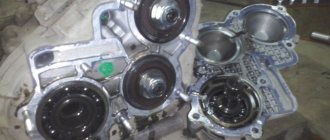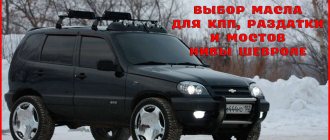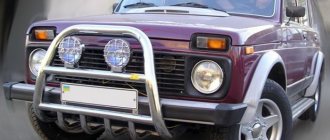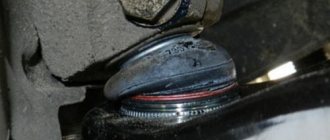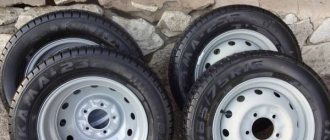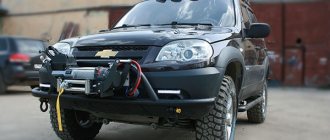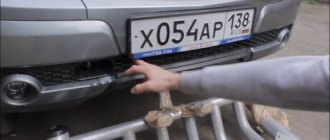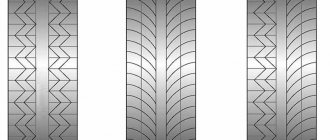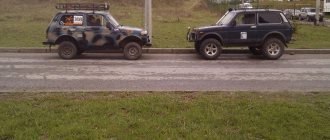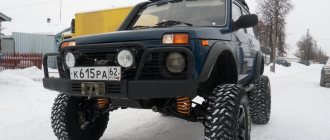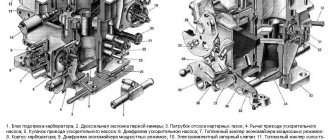Lada 4×4 3D Adventure time ⌚ › Logbook › Installation of a vibration damper and the third support of the vehicle
After installing the transfer case supports of the new model, incomprehensible knocking noises appeared, which seemed to have gotten rid of, but they came out again. I assumed that due to the “softer” supports, the transfer case sways more and this causes shocks in the transmission. This did not happen with the old supports.
Reading the next entry in the BZ on the drive, I saw that a person had installed a subframe and was giving away for a nominal fee (500 rubles) a traverse with a vibration damper and a third support of the RK. I bought it for an experiment, although delivery cost the same 500 rubles. But in general, it is several times cheaper than buying the same spare parts new in a store. =)
The vibration damper was slightly bent, or rather its mounting. I straightened everything out, assembled it, and installed the traverse. There were no problems.
I also installed the third support. I had to tinker a little, of course. I didn’t remove the plastic cover of the tunnel, although I removed the driver’s seat for ease of work. I bent the casing up a little and installed the bolts, and to prevent them from turning, I made a fixing frame.
After installing the third support, I did not center the transfer case, I set it up quickly. The vibration that was previously at 1800 rpm has shifted to approximately 2200-2300 rpm. That's okay, we need to set the transfer case to normal.
Now the transfer case should no longer nod, but, nevertheless, the shocks when changing gears remain. And everything gives off somewhere in the area of the right foot, under the heel. I started to figure it out. It turned out that there was a large gap in the flange in the rear cover of the control valve. Those. If you move the cardan up and down with your hand, you hear a good knock. If this is the reason, then how is the knocking transmitted to the legs? I don't understand. There is some play in the flange of the front cover of the RC, but not much, there is no knocking. But at the same time, the cardan rotates relative to the axis at a large angle.
Did the transfer case “nod” more strongly on the softer cushion and the bearings were broken? Let me remind you that the cardans are CV joints and there seem to be no problems.
In any case, it will be necessary to change the bearings in the transfer case covers, or better yet, change the covers to new ones with double-row bearings. But there are no funds for this yet. In the garage there is a second transfer case, removed from the same car, which was very noisy. You can try to sort it out, replace the covers and bearings. I’ve never done this myself, but I think I can do anything.
I'm going like this for now. If you try to release the clutch more smoothly and choose the right moment, then there are no shocks.
I did not check the operation of the vibration damper. You need to center the transfer case, remove vibrations from it, and only then check the car on the track.
Source
Malfunctions of VAZ transfer cases
The transfer case is not present in all VAZ passenger cars, but only on cars with two drive axles. In the transmission, the transfer case (TC) is installed at the rear of the gearbox; a rear driveshaft is attached to its shank, which connects the transfer case to the rear axle. The front axle is also driven by the steering wheel; it is connected to the transfer case by a front driveshaft. The reduction gear in the Republic of Kazakhstan is designed to obtain high torque, it is used to overcome difficult sections of the road, and helps to cope with off-road conditions. The VAZ Niva transfer case contains the following main parts:
The transfer case on the Niva is a fairly reliable unit; problems with repairs in the mechanism itself arise mainly due to insufficient oil level in the valve - if for some reason the oil leaks out, intensive wear of all parts occurs. Among the frequently occurring malfunctions are:
Operating principles of the node system
Torque is supplied to the transfer case from the gearbox via the drive shaft. After this, the moment passes to the center differential, which can be either without a locking mechanism or with a hard lock or automatic lock. If there is no lock on the differential, then the axles can rotate at different speeds, while the presence of such an element allows you to distribute torque depending on the type of track.
Self-locking differentials can be a viscous clutch (the most widely used option), a Torsen differential (has a wide torque range, but does not have the high strength required for SUVs) or a friction clutch (the differential can be locked automatically or manually, the clutch works based on frictional force).
The transfer case can have several operating modes: from connecting only the rear axle to connecting both axles with automatic differential locking between them. The transfer case is controlled manually using a mechanical lever drive. It uses the rear lever to change gears, and the front lever to engage the differential lock. The lever moves longitudinally along an axis that stands on lugs from the bracket in front of the transfer case.
There are plastic couplings in the lever hole to reduce friction. The lower end of the lever is fixed in the rod using a figured spring, and the other end of the rod is connected to the coupling by means of a fork and locked with a bolt. In order to fix the drive, a spring-loaded ball is used, which fits into the grooves of the rod. There are usually three gears on the transfer case shift rod: for high, low and neutral. The differential lock rod has two positions: “on” and “off”. There is a switch on the front axle drive cover that closes the circuit from the warning lamp if the Niva differential lock is turned on.
Transfer case Niva 21213
Model VAZ-21213 is an all-terrain passenger car with permanent all-wheel drive and differential lock. Brand 21213 is a restyled version of the first VAZ SUV, VAZ-2121. RK Niva 21213 has three gears:
21213 is equipped with 4-speed and 5-speed gearboxes, and when the first speed of the transfer case is turned on, the car operates in standard mode, the gear ratios in the transmission are from 5-speed. The checkpoints are as follows:
It’s also interesting: Properly bleed the brakes of a Chevrolet Niva with abs. When you turn on the second position of the transfer case lever (rear position), the gear ratios change (lower):
On ordinary roads, the transfer case is always in first gear, the transfer case control lever (reduction gear) is pushed forward. The neutral gear of the RK disconnects the transmission, and in this position the car does not drive; there is also a neutral in the gearbox.
Motorists often ask the question: why is neutral gear needed in a transfer case? The neutral is used when connecting additional units to the transmission, for example, a mechanical winch; in this case, a power take-off must also be installed.
Aligning the NIVA Transfer Case Without a lift 3 Ways to Center the NIVA Transfer Case
Do you want to save this video?
- Complain
Report a video?
Sign in to report inappropriate content.
Did you like the video?
Did not like?
How to center a Niva transfer case? You can do the alignment of the transfer case yourself. Vibration of NIVA transfer case. Handout killer. Check the NIVA intermediate driveshaft in 1 minute https://youtu.be/f2yWglBvgsY For those who do not have the opportunity to lift the car on a lift, you can do the alignment like this: choose a flat asphalt road, with no heavy vehicle traffic, climb under the car and loosen transfer case mounting bolts, accelerate smoothly to 80 km/h, drive 300-500m at this speed. , having released the clutch, we smoothly stop at the edge of the road (preferably in a long pocket) without leaving the smooth asphalt, turn on the emergency lights, put up an emergency stop sign and tighten the nuts securing the Niva transfer case. It is best to center the NIVA transfer case with a loaded suspension. Those. not on a lift, but on stands. That is, to center the transfer case under completely natural conditions of its operation with cardan shafts. The best results are obtained by centering them on stands under the suspension arms. (the stands must be super-reliable, otherwise they will crush you). With this centering, the cardan shafts have the same angles as when the car is moving. The success of the transfer case alignment result depends on the condition of the entire complex of components: the transfer case itself, the crosspieces and splines of the universal joints, the shaft, etc., because the complex of all the listed nodes is balanced. The splines and crosspieces of the universal joints must be carefully checked and injected. Or if there are CV joints, then check them. It is also necessary to first wash off dirt and balance all the wheels.
During the alignment process, the transfer case itself shifts to the desired balance line. Finds the desired position relative to the box and cardans. All that remains is to tighten the bolts securing the NIVA Transfer Case.
Vibration
Vibration in the body is the main “disease” of the Niva; it often occurs due to improper alignment of the transfer case. Most often, vibration occurs on VAZ 21213/21214 cars, since the transfer case is mounted only on two supports on the sides of the body; on the Chevrolet Niva, the transfer case is already installed on three supports.
Vibration when starting off on a Niva can also occur for the following reasons:
Installing the third support of the transfer case on VAZ 21213/21214 vehicles allows you to reduce the level of vibration of the transfer case; with this support it is easier to center the transfer case. The part can be purchased at auto stores or made yourself. The finished product comes with three long studs (for model 2121); to install the third support on this machine, you will need to unscrew the short studs from the transfer case housing and install new studs from the kit. We carry out repairs as follows:
Vibration is eliminated more effectively by installing a subframe under the transfer case. You can also make such a device yourself or buy a finished product at a car store.
In order to install the subframe, the transfer case must be removed. It is more convenient to carry out such work in a pit; we carry out repairs as follows:
Also interesting: Niva transfer case: repair, installation
It should be noted that installing an additional support or subframe on the steering wheel does not always lead to the desired effect; in some cases, vibration only increases.
Third pillar of the Republic of Kazakhstan
Reg.: 04/13/2009 Messages: 187 From: Khabarovsk Age: 40 Car: VAZ-2121, 1991 (USSR) [sold], Nissan Presea 1996 SR18 Manual. (I drive and spit)
I got the idea from here: https://niva.tv/reduktor_NIVA.htm But I decided not to remove the original right airbag mounts, but to make new ones using them. In the corner we drill 3 holes on the same line through 110 mm with a diameter of 10 mm. In the bottom of the car we drill 2 holes in line with the original bolts with a diameter of 8mm, also at 110mm intervals. We remove the right pillow and install 2 pillows and a “rocker arm” made from a corner (there is no need to unhook the cardan shafts). My transfer case was already centered, so I didn't center it. But you can perform the operation of centering the transfer case. Now we screw the ears to the transfer case studs and weld them to the “rocker arm”. You can do without welding, drill holes and secure it all with 2 M8 bolts. It didn't take me much time. I arrived at the garage at 19:00 and went home at 21:00. The transfer case does not lose mobility, but it is greatly limited. It’s unusual to drive uphill in 2nd and the transfer levers are standing still, the speed is 30-60-80, the levers are standing. Unusual and very pleasant. Still, I didn’t completely get rid of the vibration. The reason is that my old model with a cross had a hole. And the rear crosspiece of the rear universal joint turned out to be dead. But the vibration amplitude has decreased significantly, and the cabin has become quieter. I changed the crosspiece a day later. The spline in the front universal joint is broken (although in theory the front universal joint should generally be eternal, it is the loose transfer case that kills it). so it needs to be changed.
Ku about the third support
GO THE CHEESEER! > WHAT KIND OF KIND ARE YOU ALL BRINGING HERE. o))))))))))))))))))))))))))))))))) > And I don’t have vibrations, I don’t know what it is, show me , A!
+++ I don’t have them either, so what should I do?
But even when there were fields, there weren’t any (longer than a couple of days) :))))))))
And another question popped up. The itching intensified at 50, a slight vibration at 100 turned into concrete shaking. All cardans are from Syzran, new, in boxes.
+++ Where do these new firewood come from?
But I suggested just filling the old cardans with grease :))
Well, they probably came from some kind of Rus store.
I wasn’t too lazy, I found the text of my name For 213-214 and 2121 with an upgrade to 5 gearbox and a CV joint shaft
The weakened transfer case is balanced in the neutral position
in the zone of maximum vibrations - those at a speed of 100 km/h according to the speedometer. It is best to do this either in a pit or on a lift, pressing the rear axle with a stop until it is completely unloaded - when the axle is suspended, the transfer case tilts. It is not recommended to perform on asphalt. There have been several cases of involuntary switching on of the transfer case, contrary to all the laws of physics. And right before my eyes, too. Fortunately, there were no injuries to the person lying under the car.
The most important thing in this case is that the transfer case should not be moved to the extreme forward position (the CV joint will quickly die) or the extreme rear position (it will disassemble along the splines in the forest)
If the structure in a neutral position happily continues to vibrate - or The most common cases
1) we have a crappy wash a) Killed b) Fake (it’s not stolen, but shiny) c) Restored - there is no OTC stamp or it differs from the factory one, the studs are literally unscrewed by hand. d) Unliquid goods thrown from the factory over the fence (too many balancing holes)
2) Or at the 5th gearbox there is a repair kit from a Zhiguli gearbox with a metal sleeve with a retaining ring (usually appears after a bulkhead, or replacing the gearbox with a Zhiguli one) 3) There is no repair kit for the shank at all.
additional transfer case support
additional transfer case support
Post by Dr. Dre » May 09, 2012, 10:06 pm
Re: additional transfer case support
Post by bambr » 09 May 2012, 22:34
Re: additional transfer case support
Post by Dr. Dre » May 09, 2012, 11:18 pm
Re: additional transfer case support
Post by Portada » 09 May 2012, 23:33
Re: additional transfer case support
Post by Santey » 09 May 2012, 23:44
Re: additional transfer case support
Post by Vovanych » May 10, 2012, 10:22 am
Re: additional transfer case support
Post by Santey » May 10, 2012, 11:26 am
Re: additional transfer case support
Post by Vovanych » May 10, 2012, 12:11
Re: additional transfer case support
Post by Santey » May 10, 2012, 01:06 pm
Re: additional transfer case support
Post by tarantass » May 10, 2012, 01:22 pm
Re: additional transfer case support
Post by Santey » May 10, 2012, 01:35 pm
Re: additional transfer case support
Post by Dr. Dre » May 10, 2012, 6:38 pm
Re: additional transfer case support
Post by tarantass » May 10, 2012, 07:04 pm
Re: additional transfer case support
Post by Dr. Dre » May 11, 2012, 07:45
Re: additional transfer case support
Post by schut4x4 » May 11, 2012, 07:52
